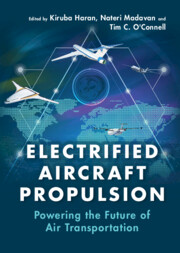Book contents
- Electrified Aircraft Propulsion
- Electrified Aircraft Propulsion
- Copyright page
- Dedication
- Contents
- Contributors
- Preface
- 1 Benefits of Electrified Propulsion for Large Aircraft
- 2 Aircraft Electric Power System Design, Control, and Protection
- 3 Megawatt-Scale Electric Machines for Electrified Aircraft Propulsion
- 4 Superconducting Machines and Cables
- 5 Conventional Power Electronics for Electrified Aircraft Propulsion
- 6 Cryogenic Power Electronics
- 7 Electrochemical Energy Storage and Conversion for Electrified Aircraft
- 8 Thermal Management of Electrified Propulsion Systems
- 9 Performance Assessment of Electrified Aircraft
- Index
- References
4 - Superconducting Machines and Cables
Published online by Cambridge University Press: 11 May 2022
- Electrified Aircraft Propulsion
- Electrified Aircraft Propulsion
- Copyright page
- Dedication
- Contents
- Contributors
- Preface
- 1 Benefits of Electrified Propulsion for Large Aircraft
- 2 Aircraft Electric Power System Design, Control, and Protection
- 3 Megawatt-Scale Electric Machines for Electrified Aircraft Propulsion
- 4 Superconducting Machines and Cables
- 5 Conventional Power Electronics for Electrified Aircraft Propulsion
- 6 Cryogenic Power Electronics
- 7 Electrochemical Energy Storage and Conversion for Electrified Aircraft
- 8 Thermal Management of Electrified Propulsion Systems
- 9 Performance Assessment of Electrified Aircraft
- Index
- References
Summary
Electrified aircraft propulsion (EAP) in large commercial aircraft demands electric machines (EMs) with power densities and efficiencies far beyond those of current state-of-the-art technologies. At fixed speed, EM power density can only be increased with electromagnetic loading. Ohmic losses in conventional conductors impose fundamental limits on this, but superconducting (SC) wires eliminate Ohmic losses at cryogenic temperatures. SC machine windings enable large electromagnetic loading increases, resulting in high-power density machines without gearboxes. SC machines are an attractive long-term option for EAP, offering several advantages: high specific power and efficiency, and reduced thermal management challenges and risks of partial discharge and arcing. This chapter introduces SC physics and key EAP SC machine design considerations. It presents several SC machine topologies currently being researched, including a detailed assessment of challenges unique to EAP applications, namely, ac losses in superconducting coils and the need for compact cryocoolers. Finally, the physics and advantages of SC cables are presented, followed by a look at future SC technology trends.
Keywords
- Type
- Chapter
- Information
- Electrified Aircraft PropulsionPowering the Future of Air Transportation, pp. 88 - 129Publisher: Cambridge University PressPrint publication year: 2022



